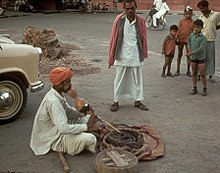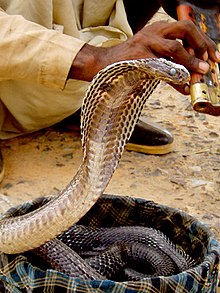snake charmer

Snake charmers are solo entertainers who pretend to be able to train snakes. They use a few tricks to make the snake appear to be "dancing" to the notes of its musical instrument.
The "conjuring" of a snake
The animals kept in dark baskets are blinded by the incident daylight when the lid is opened and fixate themselves on the first moving object they see (drowsy) as a potential opponent, which is usually the "flute" or the snake charmer himself.
This most important hand tool of the snake charmer, wrongly called the “flute”, belongs to the single reed instruments like the clarinet . The dried bottle gourd , into which two tubes with finger holes are inserted, serves as a wind capsule . The right hand operates the finger holes and creates a melody, the left tube without holes adds a deep drone tone . The Indian instrument is called pungi . A further development in the European Middle Ages led to the game of platter with a small flexible airbag, which in turn is a preliminary stage of the bagpipe .
The snake now threatens the trumpet, which moves rhythmically back and forth, back and forth, always aligning its head according to the movements of the same, in order to be able to bite at any time if the "opponent" approaches within a bite distance (about 30 centimeters). Their apparent dance is therefore initially a mere defensive position within the framework of the typical defense scheme of the respective snake species. Because of their splayed neck in this position, cobras , especially spectacled snakes, are often used for "conjuring", as they impress the viewer more than vipers, for example . For the cobra itself, the decorated gourd of the wind instrument resembles a threatening / courting conspecific, which in addition to defensive behavior also provokes their courtship and competitive behavior. Another possible trick is to the attachment of a prey spectrum covered the queue object at the end of trumpet or on an extension thereof, such as a tuft of fur, a bird feather or a dark shiny wood sphere (right). This also triggers the snake's hunting behavior. If all said methods are used together or one after the other, this apparently causes the cobra to over-stimulate its keen senses: conjurer = supposed predator = fear and threatening gestures. Cobra-like flute (pumpkin) = supposed sexual partner = arousal, interest and courtship behavior, also possible same-sex rivals = anger and turf wars. Alleged prey (fur strip, wooden ball) = appetite and hunting behavior (killer instinct). If some of these stimuli or all of them affect the snake at the same time, it seems to be mentally overwhelmed and remains in a "dance" for a long time, because it does not know which of its needs to follow first. She waits to see whether a “favorite” emerges from these contradicting and confusing stimuli.
In addition, the animal only reacts to movements and not to music (this instead influences the audience), since snakes are generally deaf and can only hear floor sound (heartbeat and body noises of the conjurer / audience), but no airborne sound (flute, singing).
Even touching and stroking the animals by the snake charmer is only possible because of the snake's confusion by the bright daylight and the many contradicting visual stimuli, when the conjurer lifts the lid of the basket and moves the special flute. Incidentally, a bite would usually not harm the summoner / spectator, as the animals' fangs are often brutally broken off or removed in some other way (these grow back, but are removed again). However, one should never rely on it and never approach a snake that has just been “conjured”. Especially in North Africa there are still a few snake charmers (Berbers, Egyptians) who do not “disarm” their cobras (here Uräus snake ) by removing their poisonous teeth, although they are ten times as poisonous as the Indian cobra . In North Africa the cobra cult of the ancient Egyptians apparently has an effect. It would still be a sin there today to mistreat a cobra, and a "real snake charmer" would not have to disarm his snake by removing its fangs, because he has mastered his (thousands of years old) craft and can with death live well in his hands. These North African snake charmers actually still worship their uraeus snakes very much today. However, they are a small minority compared to the merely commercial snake charmers.
Origin of the snakes
The animals are almost always caught in the wild and belong to protected or threatened species.
Snake charmers in popular belief
Snake charmers are in popular belief as a master of dressage of snakes viewed. In areas where the belief in spirits and magic is generally alive, especially in India , Southeast Asia , on the Pacific Islands and many other places, the snake charmers are said to have magical abilities. Allegedly they can talk to the animals. Because of their hypnosis skills , the snakes ( real cobras or king cobras ) obeyed them on their word. It is said that snake kings learn great secrets from their snakes. Allegedly a snake king could order the poisonous animals to kill other people, but a snake would never attack its master unless he asked it to. Such legends and ideas are still widespread in Asia today.
Snake charmers are always respected, but only a few are credited with these skills. They are feared and therefore not necessarily popular. The superstitious population is afraid of their “supernatural” abilities.
Indian and Asian trainers often appear as snake charmers in circus and variety shows in western countries .
Web links
- Amtul Jamil (2012): Snake and charmers (English)
- John C. Murphy (2010): Secrets of the Snake Charmer: Snakes in the 21st Century . iUniverse.
- Snake charmer with 4 cobras in Kochi (India). Youtube video


